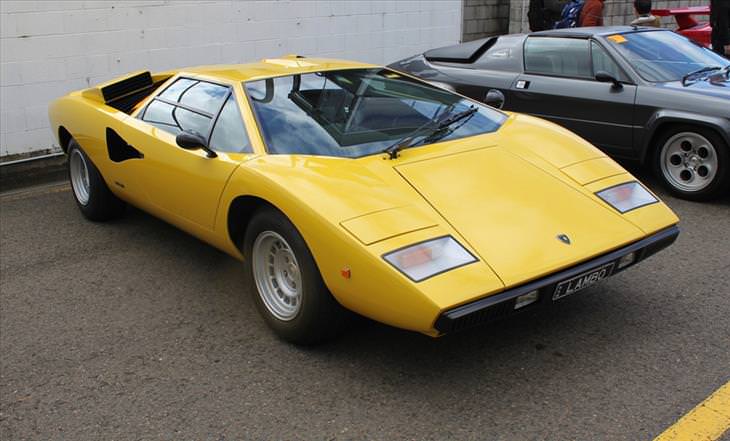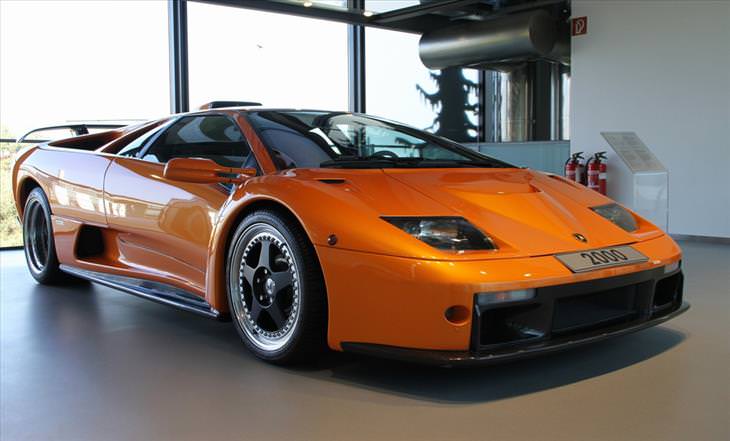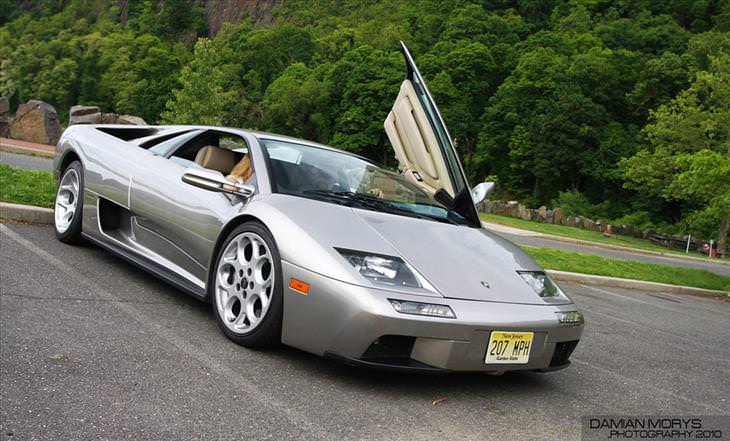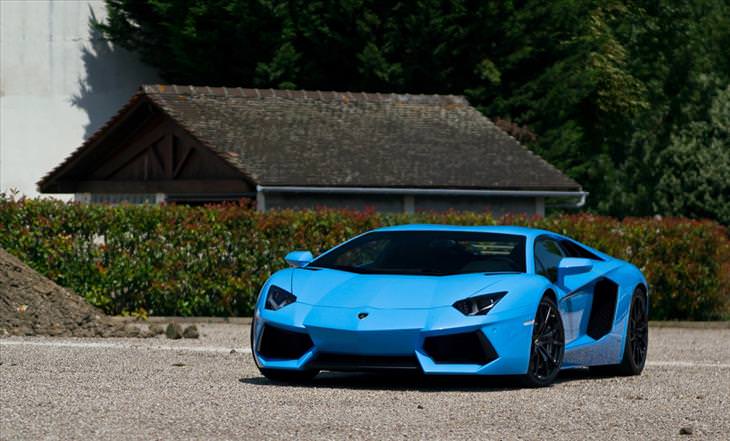The 1966 Miura (below) was actually the first car ever to be dubbed a “supercar”, and was the first in a long line of V12 Lamborghini supercars that are still being produced and sold by the manufacturer to this very day. Its 4.0-liter engine produced 350 horsepower, and could propel the car all the way to 171 mph (276 km/h).
The Miura S (below) appeared in 1969, and had 20 more horsepower over the standard Miura. Some 338 Miuras were built in S specification.
A further evolution, called the SV (below), went on sale in 1971. It featured small styling changes, employed separate lubrication for the gearbox and transmission, and had a power output of 385 horsepower. Just 150 were made.
The Bertone-designed Countach (below) shocked the world when it first appeared back in 1974. Throughout its 16-year production run, the car became heavier, more powerful, and gained many an appendage and wing, not to mention some of the fattest rear tires ever fitted to a road car. The first iteration, known as the LP400, was powered by a 4.0-liter V12 that produced 370 horsepower.

The Countach S (below) arrived in 1978, with 20 more horsepower on tap. It also gained wider wheels and the (now infamous) rear wing as an option. Although the latter would make you look cooler, it would also take 10 mph off the car’s top speed. The next model to be introduced was the LP500S, which arrived in 1982, sporting an enlarged 4.7-liter V12 engine. Oddly, there was no power hike over previous models. A further three years later, in 1985, the LP5000QV went on sale, with an even larger 5.2-liter V12 engine. With this iteration of the Countach, power went up substantially, to 455 horsepower. This meant that the car could reach 179 mph (288 km/h).
Last but not least, a 25th Anniversary model (below) went on sale in 1988 to mark 25 years since the inception of Lamborghini. It was mechanically the same as an LP5000QV, but with a body restyled by Horacio Pagani (who later set up his own operation).
When it was time to replace the Countach after its extensive production run, Lamborghini once again turned to designer Marcello Gandini, who had designed the Countach and Miura while working for the Bertone design house, to create a new car for them. The 492-horsepower, 200 mph+ Diablo (below) was the result. The car came in both four-wheel and rear-wheel-drive guises, and could also be ordered as a coupe (hard-top) or roadster (convertible).
The Diablo was upgraded and changed various times throughout its life. Notable models are the SE30 (below) and SE30 Jota, which were built to commemorate 30 years since the founding of the company. The SE30s has an extra 30 horsepower over the standard car, while the Jotas, of which less than 30 exist, churned out an astonishing 595 horsepower.
Between 1995 and 1998, Lamborghini also produced the SV, a lightweight, rear-wheel-drive only version of the standard Diablo. That car produced 520 horsepower. Ahead of the 1999 model year, Lamborghini was taken over by the Volkswagen-Audi Group, and received a substantial face-lift, together with fixed headlights and much-improved build quality. The standard car now had 530 horsepower. During that year, a very limited production run of the Diablo GT (below), with aggressive bodywork, a 6.0-liter engine and carbon fiber body panels, was initiated. Just 80 cars were built in that specification.

A redesigned version was commissioned by new Lamborghini owners, Audi, ahead of the Diablo’s replacement by the Murcielago in 2001. This car was known as the VT 6.0 (below), while the roadster version of that car was called the VT 6.0 Roadster. They featured 6.0-liter V12 engines that produced 575 horsepower – the most powerful standard Diablos to date. Designer Luc Donckerwolke’s effort was a lot more refined, civilized and generally modern – he did the legendary car justice and brought it forward into the 21st Century. These end-of-the-line Diablos represented the first Lamborghinis to have a marked presence from Audi in their DNA.

Following his refresh of the Diablo a year or two earlier, Luc Donckerwolke completed his first original design, the Murcielago (below), for Lamborghini. The first-generation Murcielago coupe went on sale in 2001, powered by a 572-horsepower, 6.2-liter V12. It was the sole model in the range until the Murcielago Roadster appeared in 2004. An interesting fact about the Roadster is that Lamborghini recommended that the canvas roof be removed for any exuberant driving over 100 mph, otherwise the driver would risk losing it entirely.
After five years in production, the Murcielago received its first major update, morphing into the LP640 (an LP640 Roadster is pictured below). The now-familiar V12 engine featured an increased displacement to 6.5 liters, and power was also up to an eye-watering 631 horsepower. Some styling changes, such as a revised front end and a massive, single-exit exhaust, also made their first appearances on the new LP640 coupes and roadsters.
Aside from other limited editions that mainly centered on cosmetic changes, the next evolution in the Murcielago lineage was LP670-4 SV (below) - a lightweight, stripped-down version of the LP640. Power was upped once again, this time to 661 horsepower. This made the car capable of reaching 212 mph (341 km/h). Only 186 SVs were ever built.
The Reventon (below) is essentially a Murcielago LP640 underneath, however, with a completely restyled body and interior. In fact, its instrument panel consists of liquid crystal displays, and there are hints of fighter jet absolutely everywhere you look. Just 20 coupe and 15 roadster versions of this car were built, and all were sold for at least $1.2 million each.
The Filippo Perini-designed Aventador (below) marked the first time in a whopping 45 years that Lamborghini employed a brand-new V12 engine design in one of its flagship models. Amazingly, the Miura, Countach, Diablo and Murcielago were all built around the same engine, albeit with ever-increasing displacements and the addition of things like variable valve timing (Diablo onwards). The 691-horsepower LP700-4 broke cover in 2011, with blinding performance figures of 0-62 mph (0-100km/h) in 2.9 seconds, and a top speed of 217 mph (350km/h).

The LP700-4 Roadster was first announced in December 2012, with production starting in 2013. A 50th Anniversary Aventador, marking the 50th anniversary since the founding of Lamborghini, was produced in 2013. Some 100 LP720-4 50° Anniversario (below) roadsters and a further 100 coupes were built, all colored in Giallo Maggio (May Yellow), which was a model-specific color. These cars were slightly more powerful than the launch Aventador, with 710 horsepower on tap.
The LP750-4 SV model (below), a lighter, more powerful version of the car, went on sale in 2015. In addition to the weight loss, the car also featured new wheels, a large rear spoiler, as well as revised aerodynamics. The Aventador’s power now stood at 750 horsepower. The LP750-4 SV Roadster went on sale in 2016, at a base price of $530,000 in the US.
Yet another car created to commemorate 50 years since the inception of Lamborghini was the $4.5 million Veneno (below). Just five coupe and nine roadster examples of this insane-looking car, based on the Aventador, were built. The Veneno is capable of reaching 221 mph (356 km/h).
As you might have gathered by now, Lamborghini really loves anniversaries. The Centenario (below) is also based on the Aventador, however it is vastly reworked to commemorate what would have been Lamborghini founder Ferruccio Lamborghini’s 100th birthday. Deliveries of the $2.4 million car will begin shortly, with 20 coupes and a further 20 roadsters up for grabs.
Image Sources: 1,2,3,4,5,6,7,8,9,10,11,12,13,14,15,16,17,18,19
